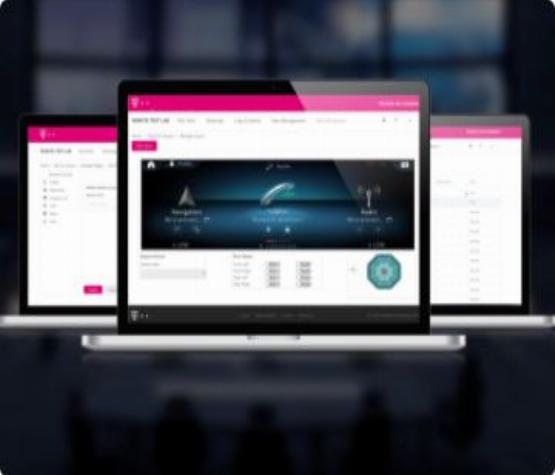
The Remote Testlab frees car manufacturers from the previous limitations of physical hardware tests. It makes location-independent test series possible, allows better utilization of prototypes and accelerates development cycles.
Software at the heart of the car
Woman sitting in a connected car making changes on the touch display
Cars are becoming increasingly intelligent and connected cars are the future. For example, they support their drivers with well-meaning advice on road safety ("Attention! The speed limit here is 50 kilometers per hour") or with regard to service: "Oil change and inspection due in 3100 kilometers". Human Machine Interfaces (HMI) form the modern interface between manufacturer and customer and contribute significantly not only to the usability of the car, but also to the overall brand experience. But this can become clouded if the display in an electric car prompts you to change the oil.
Testing is essential
It is possible that this could pass for a new form of "infotainment" – a head unit or instrument cluster in the vehicle that understands fun. What may seem rather curious in this example could be quite dangerous in other forms – or create legal problems (for example, if an instruction manual does not comply with the legal requirements). The software and hardware in the car must function perfectly. It's not just about providing the best experience for customers. In fact, flawless functionality – especially when cars are becoming increasingly "software-defined" – is a prerequisite for vehicle registration.
Car manufacturers put a lot of energy into testing their hardware and software for good reason. A shift-left approach is becoming more and more established. The sooner errors are detected, the sooner they can be corrected and the less time and effort (and costs) is required. A error discovered early is a good error. An error discovered late causes development engineers to sigh deeply – and usually very loudly. The effects on a company's reputation and image are usually much greater than the actual fault in the machine itself.
Development with real, physical hardware
In early test phases, the hardware-software interaction can still be virtualized, but as the vehicle development project progresses, there comes a time when real hardware needs to be tested in conjunction with the software. And it usually becomes clear by then at the latest that the real hardware does not always behave as the developer wishes. Theory meets practice. The tests on and with the real hardware are therefore an essential part of quality assurance in vehicle development.
Traditionally, hardware components are physically put through their paces with special tools in test labs. The manual processing of test cases and the associated on-site presence are indispensable. Traveling or setting up a test site close to the place of development generates considerable costs.
